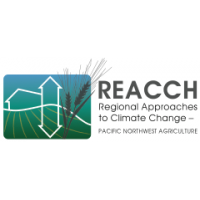All historical data are based on average of 31 years in historical (baseline) period from 1979 to 2010. All the data under future folder are based on average of 31 years in future period from 2055 to 2085 which is presented as 2070s. Also we used 12 GCMs in our study and the results in this folder are the average of 12 GCMs. Annual Crop-Fallow transition (CCF), Annual Cropping (CC) and Grain-Fallow (CF): These areas represent the cropping system (rotation) that were used for simulation over the different classes of REACCH study area: Annual crop-fallow transition or CCF is winter wheat (WW) - spring wheat (SW) - summer fallow (SF) which is a 3 years rotation Annual cropping or CC is winter wheat (WW) - spring pea (SP) - spring wheat (SW) which is 3 years rotation Grain-fallow or CF is winter wheat (WW) -summer fallow (SF) which is 2 years rotation RCP 4.5 and RCP 8.5 For the future periods, we used two representative concentration pathways (RCP) based on global warming potential of 4.5 and 8.5 Wm-2 Excel files makeup: Each excel file represents the outputs of CropSyst which has a crop yield for each scenario and the associated variables for that crop during its growing season. These are the list of columns in each excel file: It is representing the grid cells in the REACCH study area with the resolution of 4*4 km which are as the same as weather input data. For each grid cell CropSyst simulate next variables based on input data, and using the rotation specified in the folder name: daytime_VPD_avg Average of day time vapor pressure deficit (kp) yield (kg/ha) residue_biomass (kg/ha) ET_pot Potential Evapotranspiration (mm) ET_act Actual Evapotranspiration (mm) transp_act Actual transpiration (mm) evap_soil_act Actual soil evaporation (mm) evap_residue_act Actual residue evaporation (mm) precip Precipitation (mm) air_temp_avg Average air temperature (C) crop_water_intrcpt Water intercepted by crop (mm) residue_water_intrcpt Water intercepted by residue (mm) soil_water_drainage (mm) avg_water_stress_index Average water stress experienced by crop during growing season (no unit- between 0 to 1 and number closer to 1 means more stress) avg_temperature_stress_index Average temperature stress experienced by crop during growing season (no unit- between 0 to 1 and number closer to 1 means more stress) Srad Solar radiation (MJ/m²) Tmax Average of Maximum Temperature (c) Tmin Average of Minimum Temperature (c) season growing season length (days)
Data and Resources
| Field | Value |
|---|---|
| Modified | 2017-01-26 |
| Release Date | 2017-01-26 |
| Publisher | |
| Identifier | nkn:{8D116DEF-C077-4516-AFE2-E94ABE4C81D0} |
| Spatial / Geographical Coverage Location | -180,-90,180,90 |
| License | Creative Commons Attribution Non-Commercial Share-Alike (CC-BY-NC-SA 4.0) |
| Public Access Level | Public |
| POD Theme | geospatial farming climatologyMeteorologyAtmosphere |
| Harvest Source Title | REACCH PNA |
| Harvest Source URI | http://nknportal.nkn.uidaho.edu/final.json |
| Last Harvest Performed | Fri, 02/01/2019 - 17:30 |

